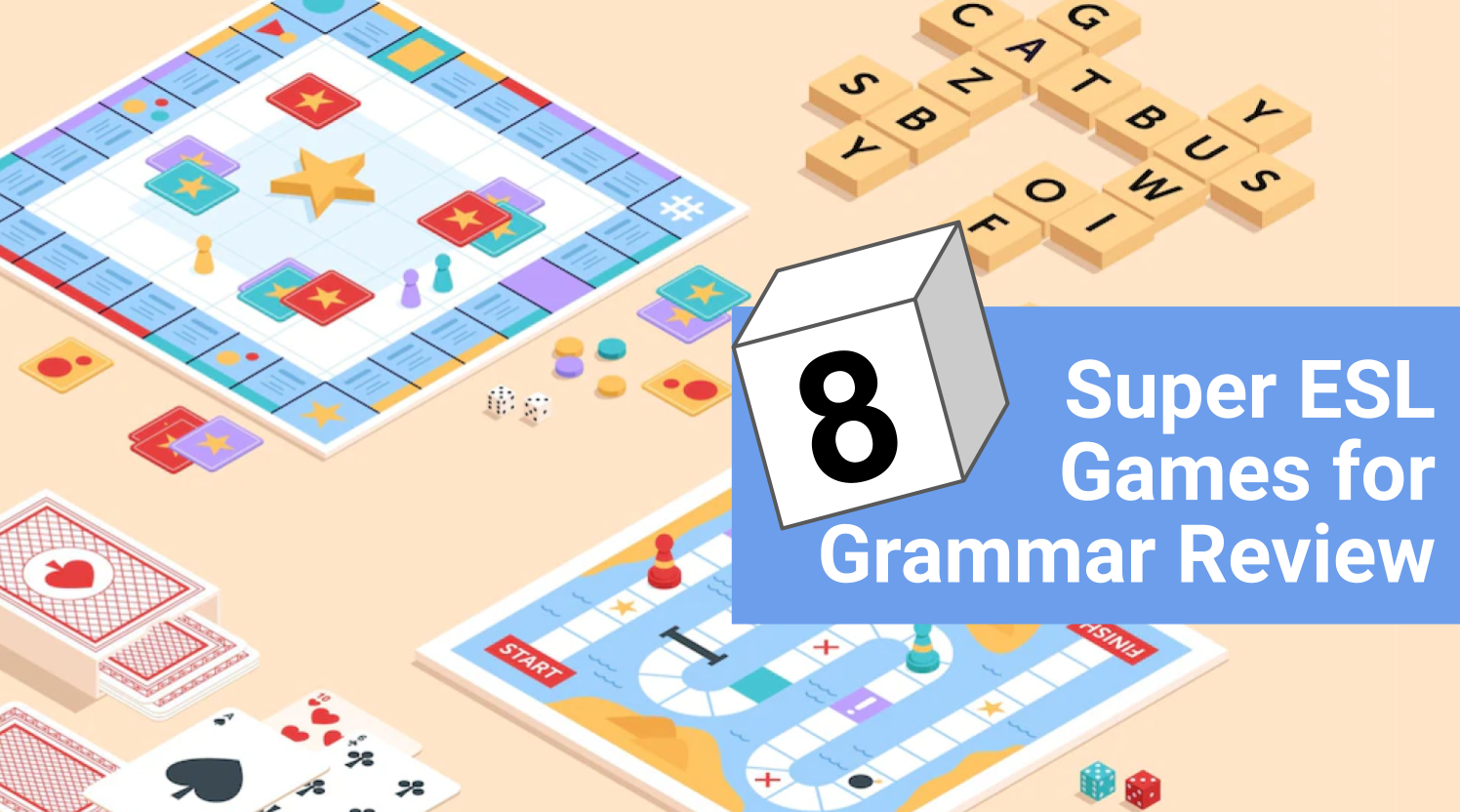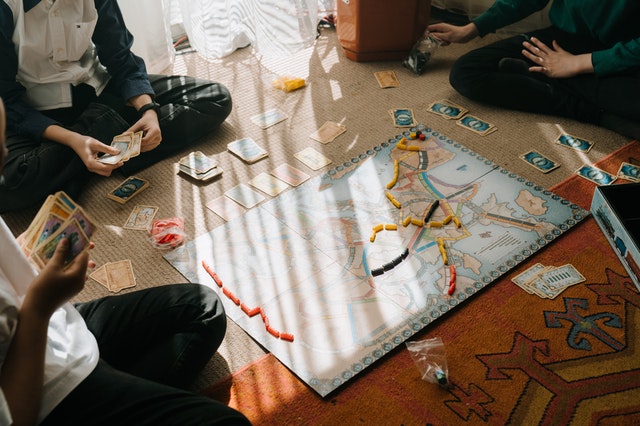8 Super ESL Games for Grammar Review
by Claudia Pesce
520,352 views
Have you ever noticed that students start disappearing right about the time you start reviewing for a test?

Review lessons can be boring enough, but grammar reviews are precisely the type of thing that make students want to skip class and reappear only for the test. Now, what if you were to give your students a grammar review they wouldn’t want to miss? Here are some classic games you can adapt to any level and use to review essential structures. You will have a full classroom during your review lessons – guaranteed!

Try These 6 Super ESL Games for Grammar Review
-
1
Shoot for Points
We often need to review things that are not fun, such as things like the past simple or past participle of irregular verbs. Instead of the classic Q & A, try this. Use a large container or trash can as your “basket”, give your students a ball and have them shoot for points. But here’s the catch: you’ll ask them a question in past simple, and they’ll have to remember the past correctly in order to earn the chance to shoot. Give them 10 points for scoring or five if they miss (because at least they answered the question correctly). You can vary this type of game, whether you use large balls or small ones, or even a wadded-up piece of paper.
-
2
Board Game
Everyone loves a board game, and your ESL students will particularly appreciate one if it’s not only loads of fun, but also a helpful way to review essential grammar. You can design your own game to include the tenses and structures your students have learned, or use any of the ones already available at BusyTeacher.org. This Grammar Revision Board Game is a perfect example.
-

-
3
Tic Tac Toe
Tic Tac Toe is another versatile game and one that can be adapted to suit a wide variety of needs. What you need to decide first is which grammar your students need to review for the test. Then, write the topics on nine index cards or large enough pieces of paper. Arrange the cards face down on a table or stick them on the board, in the classic Tic Tac Toe 3 x 3 grid.
Next, teams take turns choosing a square (you can add letters across and numbers down to make it easier to call out the squares). You turn over the card and reveal to your students the tense/structure/grammar point written on it to your students. They must then either provide an example or ask a question that another team member must answer correctly to get their X or O on that square. Of course, the first team that gets three Xs or Os in a row across, down, or diagonally wins.
-
4
Snakes and Ladders
To play this classic game in your grammar review lesson, you’ll first need to prepare some cards: they may have verb tenses written on them, questions your students must answer or prompts from which to say a complete sentence.
-

The rules are simple, and the game is so much fun! Let us dive in:
1. Students must first choose a token to move around the board (a different colored button for each will do nicely!)
2. Then they take turns rolling the dice to move across the board
3. They must take a card and answer correctly to remain on that spot, or move back two places if they are incorrect
4. If they land at the bottom of a ladder, and they answer correctly, they get to move up the ladder
5. If they land on a snake’s head they automatically move down to where its tail is
-
-
5
Football!
This is a game I’ve played with students of different ages and levels with tremendous success. First, you’ll need to draw a playing field on the board or on a large piece of paper:
Next, divide your students into two teams. Place a “ball” token at the center. Then, students must answer questions correctly to approach the posts and score a goal. For example, Team A answers correctly and moves right one step closer to their goal. Team B answers correctly and moves the ball left back to the center. Team A answers incorrectly and can’t move the ball at all. Team B answers correctly and moves left one step closer to their goal. If Team A keep answering incorrectly and Team B correctly, then Team B will continue moving left to eventually score a goal. When a team scores, the ball moves back to the center, and the team that did not score last starts. The team with the most goals wins.
-
6
Jeopardy
I’ve mentioned this game in several articles, and it happens to be my personal favorite. There is so much you can do with it – you can review everything they’ve learned in a single fun game. You’ll find it explained here. All you have to do is replace the categories at the top with tenses or grammatical structures you want them to review. The game Jeopardy is a good educational choice and great fun for kids of just about all ages.
-
7
Where am I?
This is a guessing game where the class takes turns to give clues to a classmate who must guess where they are. Write a place on the board, for example, the kitchen, library, store, car, swimming pool, or sports field. One student stands at the front of the class, with their back to the board. The rest of the class take turns to give a one-sentence or one-word clue about where they are. For example, if the place on the board is ‘In Class,’ a clue could be, “You have a pen in your hand.” After each clue, the student in front must guess where they are. If their guess is incorrect, further clues are given. If their guess is correct, they sit down, and a new student comes to the front. You can use the person who gave the last clue to go next. Write a new place on the board, and repeat the process with a new student. You can award points when students get it right the first time.
-
8
Reverse Charades
Reverse Charades is a fun twist on the classic game of Charades. Instead of one person acting out a clue for a team to guess, the reverse happens. Use flashcards or write a word on the board. Divide the class into teams. Each team chooses one member to be the guesser. The rest of the team then acts out clues for the one person to guess, who has 60 seconds in which to guess as many words as possible. Each correct word get one point. Take turns with each team. The one with most points wins. You can use the names of movie characters, nouns, sports, gardening, cooking or holidays, like Halloween. Reverse Charades can be hilarious because it’s quite a fast-paced game.
Why Grammar Games?
There are many fun games you can use to teach and review grammar. We found these two: Grammar Police. The game features commonly found texts where players identify the grammar and spelling mistakes. It includes the funniest ones from TV, newspapers, adverts, social media and road signs. Word Teasers. This game includes vocabulary flashcards and conversation starters to stay sharp for their next test and help middle schoolers to build their vocabulary and enhance their grammar by improving their reading and writing skills.
Not all grammar reviews have to be cut and dried. Don’t underestimate the power of games – they help students use the resources they’ve acquired in creative ways.
They engage learners to put the things they’ve learned to good use. The competitive environment motivates them to give it their best effort.
If you’ve ever used these games for review, please tell us about your experience below. And feel free to suggest other great games for grammar reviews!
P.S. If you enjoyed this article, please help spread it by clicking one of those sharing buttons below. And if you are interested in more, you should follow our Facebook page where we share more about creative, non-boring ways to teach English.

Get the Entire BusyTeacher Library:
Dramatically Improve the Way You Teach
Save hours of lesson preparation time with the Entire BusyTeacher Library. Includes the best of BusyTeacher: all 80 of our PDF e-books. That’s 4,036 pages filled with thousands of practical activities and tips that you can start using today. 30-day money back guarantee.
Learn more




